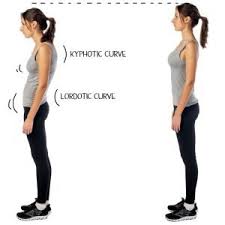
Kyphosis refers to is an abnormally excessive convex curvature of the spine as it occurs in the thoracic and sacral regions.
Kyphosis can result from degenerative disc disease; developmental abnormalities, most commonly Scheuermann’s disease; osteoporosis with compression fractures of the vertebra; multiple myeloma; or trauma.
The normal thoracic spine extends from the 1st thoracic to the 12th thoracic vertebra and should have a slight kyphotic angle, ranging from 20° to 45°.
When the roundness of the upper spine increases past 45° it is called kyphosis or hyperkyphosis.
Scheuermann’s kyphosis is the most classic form of hyperkyphosis.
Scheuermann’s kyphosis is the result of wedged vertebrae that develop during adolescence.
The cause is not currently known and the condition appears to be multifactorial and is seen more frequently in males than females.
This causes a bowing of the back, seen as a slouching posture.
Kyphosis is distinguished from scoliosis, a condition in which the spine has a sideways curve.
High degrees of kyphosis may be associated with severe pain and discomfort, breathing and digestion difficulties, cardiovascular irregularities, neurological compromise and, in the more severe cases, significantly shortened life spans.
Severe curves typically do not respond well to conservative treatment and almost always warrant spinal fusion surgery, which can restore the body’s natural degree of curvature.
The risk of serious complications from spinal fusion surgery for kyphosis is estimated to be 5%.
5% of patients require reoperation within five years of the procedure.
Surgery is a cosmetic choice.
Kinds of kyphosis:
Postural kyphosis is the most common type, normally attributed to slouching, can occur in both the old and the young.
In the young, slouching is reversible by correcting muscular imbalances.
In the old, it is called dowager’s hump.
About one third of the most severe hyperkyphosis cases in older people have vertebral fractures.
The aging body moves towards a loss of musculoskeletal integrity, and hyperkyphosis can develop due to aging alone.
Scheuermann’s kyphosis is significantly worse cosmetically and can cause pain.
Scheuermann’s kyphosis can also affect different areas of the spine, but most commonly being the midthoracic area.
Scheuermann’s kyphosis is considered a form of juvenile osteochondrosis.
Scheuermann’s disease is found mostly in teenagers and presents a significantly worse deformity than postural kyphosis.
A patient with Scheuermann’s kyphosis cannot consciously correct posture.
The apex of the curve, located in the thoracic vertebrae, is quite rigid, and may be associated pain,
which can be aggravated by physical activity and by long periods of standing or sitting.
In postural kyphosis, the vertebrae and discs appear normal.
Fatigue is a very common symptom, with kyphosis because of the intense muscle work that has to be put into standing or sitting properly.
Kyphosis appears to run in families.
Most patients who undergo surgery to correct their kyphosis have Scheuermann’s disease.
In Congenital kyphosis the spinal column does not develop correctly in the womb.
Vertebrae may be malformed or fused together and can cause further progressive kyphosis as the child develops.
Surgical treatment may be necessary in congenital kyphosisat a very early stage and can help maintain a normal curve.
A congenital kyphosis can appear in the teenage years, more commonly in children with cerebral palsy and other neurological disorders.
Nutritional kyphosis can result from nutritional deficiencies, especially during childhood, such as vitamin D deficiency:
softening bones and resulting in the curving of the spine and limbs under the child’s body weight.
Gibbus deformity kyphosis, often a sequela to tuberculosis.
Post-traumatic kyphosis can arise from untreated or ineffectively treated vertebral fractures.
Kyphosis can be graded in severity by the sagittal balance, which is the horizontal distance between the center of C7 and the superior-posterior border of the endplate of S1 on a lateral radiograph.
A diagnosis of kyphosis is generally made through observation and measurement.
Osteoporotic associated kyphosis, can be confirmed with a bone density scan.
Postural thoracic kyphosis can often be treated with posture education and focused strengthening exercises.
Thoracic kyphosis due to vertebral wedging, fractures, or vertebral abnormalities is more difficult to manage.
Assuming a correct posture may not be possible with structural changes in the vertebrae.
Children who have not completed their growth may show improvements with bracing.
A variety of gravity-assisted positions or gentle traction can minimize pain.
Surgery may be recommended for severe idiopathic kyphosis.
There are different curve patterns for the thoracic, thoracolumbar, and lumbar types of braces.
Surgical treatment can be used in severe kyphosis cases.
With progressive kyphotic deformity due to vertebral collapse, a kyphoplasty may arrest the deformity and relieve the pain.
Kyphoplasty is a minimally invasive procedure, requiring only a small opening in the skin to return the damaged vertebra as close as possible to its original height.
